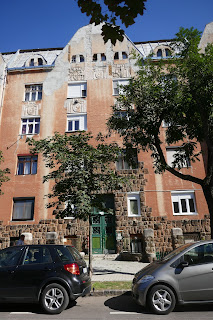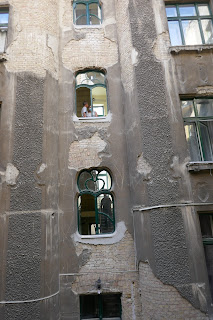I was listening to an interview with the journalist Simon Heffer the other day, (Note No. 1), in which Heffer describes a visit to his cousin Eric Heffer in Liverpool in the 1990s. "He drove me around the bits of Liverpool where those nasty 1960s tower blocks had been demolished", Simon Heffer explains, "and the Militant Tendency council had built really nice, sort of modern Coronation Street style, back-to-back housing - and I said, 'I say, these are rather good, aren't they', and Eric said, 'Yeah, they are, they're much too good for the workers - the problem is, with these, that the tenants are now buying them ... That wasn't the plan at all!'"
The week before hearing that I'd been on a couple of walks in Budapest and happened upon some really beautifully made social housing from earlier times. One example was on the way to the Railway Museum, (about which more another day). This set of housing was built in 1911 for railway workers. Sadly it was damaged in the war and afterwards the copper covered spires that were part of it originally were never restored - but you can see a photograph of it in its original glory here (there is a great deal more detail about it here - but in Hungarian - including the name of the architect and an explanation of the significance of the decorative motifs, which have something to do with train engineering, but I couldn't quite understand what exactly, as the deficiencies in my understanding of Hungarian and the deficiencies in my understanding of engineering came together to mystify me at that point):
Both these housing developments seemed to me to have many thoughtful and "unnecessary", (that is, not purely utilitarian), attractive touches. One is supposed to believe that in the past there was a greater tendency to oppress the masses and that we are more enlightened now about how we take care of the less well off. Perhaps Eric Heffer revealed the truth - that authorities decided the accommodation they provided shouldn't be too nice or everyone would be clamouring for it. Possibly. My theory though is that everything became about theory. Instead of designing with instinct and common sense, architects began to design according to theories. People ever since have had to live with the results.
Note No. 1: It was part of the podcast series called Confessions by Giles Fraser, which is quite good, apart from Fraser's habit of saying at least once in each episode, "Of course, I'm an old Leftie", a desperate bid to keep his credentials up to date with that side of things, I suppose.









































No comments:
Post a Comment